HOMEBasement Waterproofing solutions: Sump Pump guides: More Waterproofing resources: |
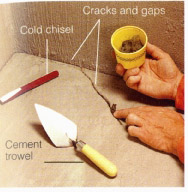 Hydraulic Cement
Hydraulic Cement
Undercut cracks using a cold chisel. Pack hydraulic cement into gaps and cracks and trowel it smooth. On concrete block walls, chisel a groove only in cracks in mortar joints. Cement hardens in five minutes and can block actively flowing water.
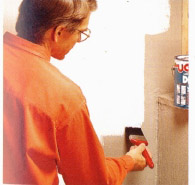 Waterproof
Paint
Waterproof
Paint
Remove dirt, flaky paint and chalky residue from walls. Apply waterproof paint according to manufacturer’s directions. Some products go over raw concrete, others over painted walls. Use only for minor seepage problems.
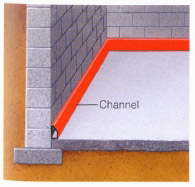 Water
Dam
Water
Dam
This water dam system catches water at the wall’s base above the floor (unlike drain tile, which catches it below the floor). The enclosed channel carries water to a sump where it’s pumped outside. The system is less expensive than drain tile, but less effective.
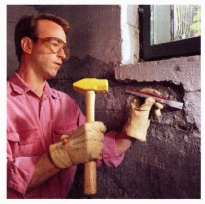 CWM Waterproofing
CWM Waterproofing
1. Crystalline waterproofing material (CWM) penetrates deep into concrete to make it waterproof. Chisel or scrape away loose concrete or other coatings, leaving no coating patches larger than a silver dollar.
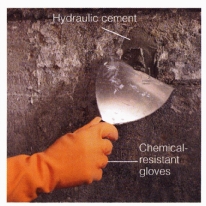 2. Fill cracks and holes with hydraulic cement. Cement
sets quickly, so mix only as much as you can use in three minutes. Both
hydraulic cement and CWM generate heat as they cure, so the mixing container
may feel warm.
2. Fill cracks and holes with hydraulic cement. Cement
sets quickly, so mix only as much as you can use in three minutes. Both
hydraulic cement and CWM generate heat as they cure, so the mixing container
may feel warm.
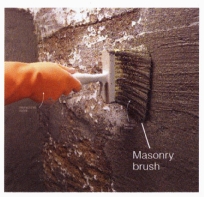 3. Wet the concrete until it’s soaked but not dripping.
Smear a thick coating of CWM over concrete. Mix only as much CWM as you
can spread in 10 minutes. Keep the coating damp for 48 hours after application.
3. Wet the concrete until it’s soaked but not dripping.
Smear a thick coating of CWM over concrete. Mix only as much CWM as you
can spread in 10 minutes. Keep the coating damp for 48 hours after application.
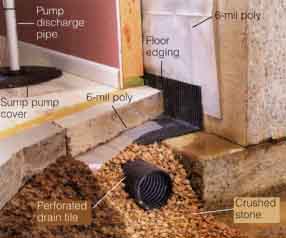 Drain Tile with Sump Pump
Drain Tile with Sump Pump
If all other measures fail to prevent water penetrating your basement, you may have to install an interior drain tile and sump basin -- a massive job. To install this system, first find a location for the sump in an unfinished space and plan for its electrical and discharge requirements. Remove an 18-in. (45-cm) strip of concrete flooring around walls and dig an 8-in. (20-cm)- deep trench along the footing. Fill the trench with 2 in. (5 cm) of gravel and lay the perforated drain tile in a complete loop to and from the sump basin. Cover the tile with gravel, hang 6-mu plastic sheeting on the wall and install corrugated floor edging. Cover the gravel with 6-mil plastic, patch the concrete floor and install the sump pump. Only then should you frame the intenor walls.
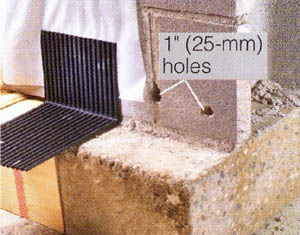 If you have a concrete block foundation, you’ll have to
drain the block cores by drilling 1-in. (25-mm) holes through the face
of the block. Water will run down the inside of the floor edging and be
directed to the drain tile.
If you have a concrete block foundation, you’ll have to
drain the block cores by drilling 1-in. (25-mm) holes through the face
of the block. Water will run down the inside of the floor edging and be
directed to the drain tile.